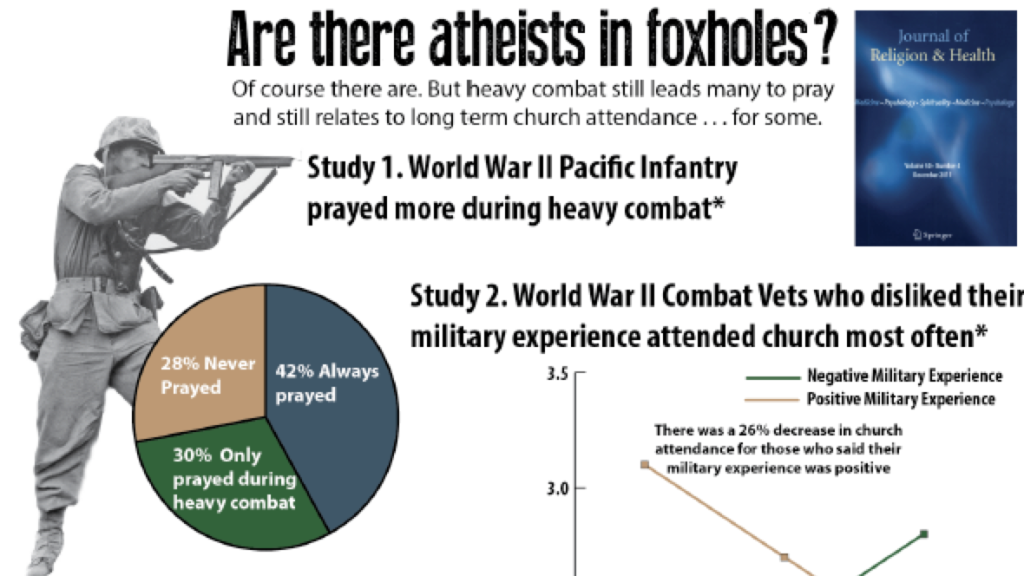Wansink Veteran Prayer Study Illuminates Foxhole Atheists
Two brothers, Drs Brian and Craig Wansink have self-funded and directed a study of responses to combat stress in and after military service. The study was published in the independent Journal of Religion and Health.
The interim media coverage showed combat vets pray in response to stress. Many outlets friendly to nontheists were quick to condemn the negative press. Unfortunately some were critical of the study even though it hadn’t yet been published. MAAF contacted the authors to request the full study. It took a few weeks, but it is important to view the science even if it may not be favorable.
Waiting for the study provided a better insight into the research and the researchers. It is true; the study had frequent references to the old canard about no atheists in foxholes. However, the researchers concluded with a James Morrow quote favored by atheists: “Saying there are no atheists in foxholes may be less of an argument against atheism than it is against foxholes.” The research also found that 28% of Pacific Infantry never prayed, even during heavy combat, so the study proves more than disproves the service of atheists in combat.
Video with research Brian Wansink: Study Summary
Full study (behind pay-wall): Download the research — Download the entire paper
Both researchers were very positive and appreciative of the outreach from MAAF. The published study included an infographic which also includes a link to the MAAF site. And even though many media reports led with their headline “Are there Atheists in Foxholes”, the infographic provides the answer of the researchers: “Of course there are.” They have also published an atheist outreach page. Dr Brian Wansink responded to our initial inquiries with this positive note:
One of our findings was that for some veterans — particularly some of those who believed their war experience to be positive — were less religious with increased combat. This makes the work of you and your organization valuable as a means to constructively share or gain meaningful support and understanding among a critical group of veterans. I loved your “Chaplains Click Here” page. The research really shows the complementary nature of the two institutions.
MAAF also reached out to the Center for Atheism Research, specifically to Dr Ryan Cragun (sociology) and Joseph Hammer (a doctoral student in counseling psychology). Mr Hammer first pointed out that 18% were frightened and had high levels of fear symptoms but did not turn to prayer for support. So there are atheists in foxholes, but the other results of the study do show a tendency to pray in combat. More intriguing to Mr Hammer was the finding that only those who had a negative military experience tended toward prayer.
Dr Cragun provided an alternate perspective.
People who came away from their military experience saying it was positive or who were not frightened by heavy combat are psychologically different. And that would align with what we know about less religious and nonreligious people – they are more accepting of change and are less likely to express fear, both in general and in the face of death. Thus, what the authors have really found is more evidence to support the idea that there are psychological differences between religious and nonreligious people.
Reversing the arrow of causation, Dr Cragun even opined that atheists might make better soldiers since they were less likely to succumb to fear or to pray in the face of danger.
One might also conclude that those continuing to attend church were unable to find ways to reconcile their war experience with their personal identity. Those who left the church were better able to find personal solace in secular or humanistic ways.
This study and others should be reviewed on its merits and compared with other studies, not dismissed on for its potential implications. Overall this is fascinating research from which we can better understand the draw toward prayer and the need for non-prayer solutions to combat recovery.
Study Quick Overview:
“Study 1 examines the relationship between combat and religious behavior in the context of how motivating soldiers found prayer under different levels of combat intensity.” This study drew from 163 surveys of Pacific-theater US infantrymen conducted in March-April 1944 (published 1949). To examine the long-term impact of combat on a wider range of religious behaviors, Study 2 self-reported religious behavior 50 years after combat. The participants were a national sample of 7500 WWII veterans. The question was, “When the going was tough, I found motivation,” from prayer, home, hatred, mission. They were also asked about what they did when scared or not scared in a frightening or non-frightening battle (four combinations). As combat became more frightening, the percentage of soldiers who reported praying rose from 42 to 72%, drawing from the other three sources of motivation, which were relatively flat for all situations.

